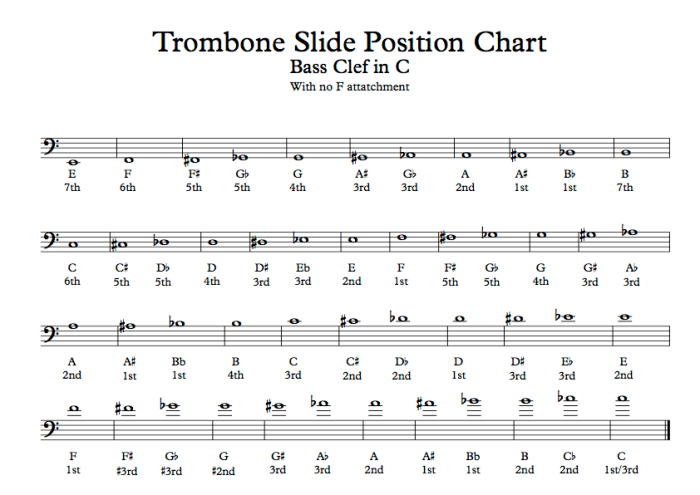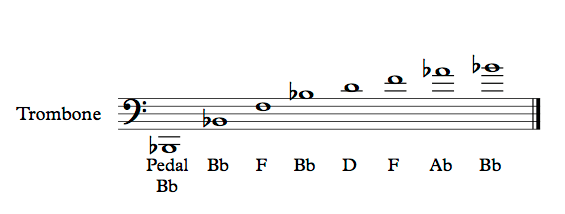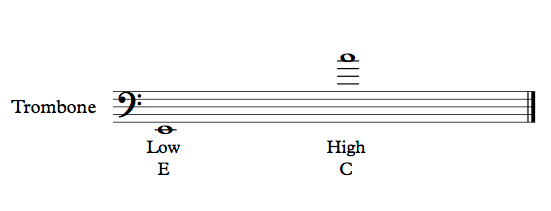from spinditty.com
Below, you'll find a useful chart that shows the most commonly used slide positions for trombone (bass clef in C). Some trombones have a trigger which is referred to as an F attachment and replaces 6th position. This chart is for a standard tenor trombone without a trigger. The positions marked #2nd and #3rd are to be played slightly shorter.

The Open Notes on a Tenor Trombone
The trombone has several "open notes" that are all played on the lip with the slide in. These are the same notes as the harmonic series that a bugle plays. You move between the open notes by tightening your lips to play higher and loosening them to play lower. The main open notes (listed from lowest to highest) are Pedal Bb, Bb, F, Bb, D, F, Ab and top Bb. More skilful players develop their range but generally the highest note at Grade 8 is a top Bb.

The open notes/harmonic series
The Range of a Tenor Trombone

How Many Notes Can the Trombone Play?
Although the tenor trombone doesn't have valves like a trumpet, it can still play a fully chromatic scale of about 2 and a half octaves. The lowest commonly used note on the trombone is a written E below stave (bass clef). The highest note, for most competent players, is a high C, which is written an octave above the stave (bass clef). The tenor trombone can also play a lower pedal Bb. A trombone with an F attachment can extend chromatically into the lower notes.
How Does Slide Work on a Trombone
With just the open notes, you are limited to what you can play. To make the trombone fully chromatic, you will need to use the slide. On the trombone there are 7 slide positions. By extending the slide you lower the pitch of each open note.
What the 7 Slide Positions on Trombone Do
Where Are the Slide Positions on a Trombone
The exact position of each note may vary from trombone to trombone. The best way to find the exact slide position for each note is to use a tuner. Make sure the note F (4th line bass clef) is in tune by using the tuning slide at the back of the trombone. You can then find the exact position of each note by descending chromatically through the positions.
The positions on the trombone are as follows.
I have used the open note F as an example.
Take Care of Your Slide
It is important to take care of your slide so you can move quickly and fluently between the slide positions. The best way to keep your slide in good condition is to wipe clean the inner slide with a cloth removing any old dirt and grime. Then apply some slide cream such as slide-o-mix to the inner slide working the outer slide back in. You can then use a water spray on the slide to make it even faster!
Trombone Slide Position Video
By Tim Curd



- 1st Position: Open
- 2nd Position: Lowers the pitch by a semitone
- 3rd Position: Lowers the pitch by 2 semitones (a tone)
- 4th Position: Lowers the pitch by 3 semitones (a minor 3rd)
- 5th Position: Lowers the pitch by 4 Semitones (a major 3rd)
- 6th Position: Lowers the pitch by 5 semitones (a perfect 4th)
- 7th Position: Lowers the pitch by 6 semitones (an augmented 4th)
- 1st Position: (F) In.
- 2nd Position: (E) Out about an inch and a half.
- 3rd Position: (Eb) Fingers by the bell.
- 4th Position: (D) Wrist by the bell.
- 5th Position: (C#) Wrist just past the bell by about 2 inches.
- 6th Position: (C) Nearly a full reach. You shouldn't be able to see the stockings.
- 7th Position: (B) Just past the stockings.
By Tim Curd